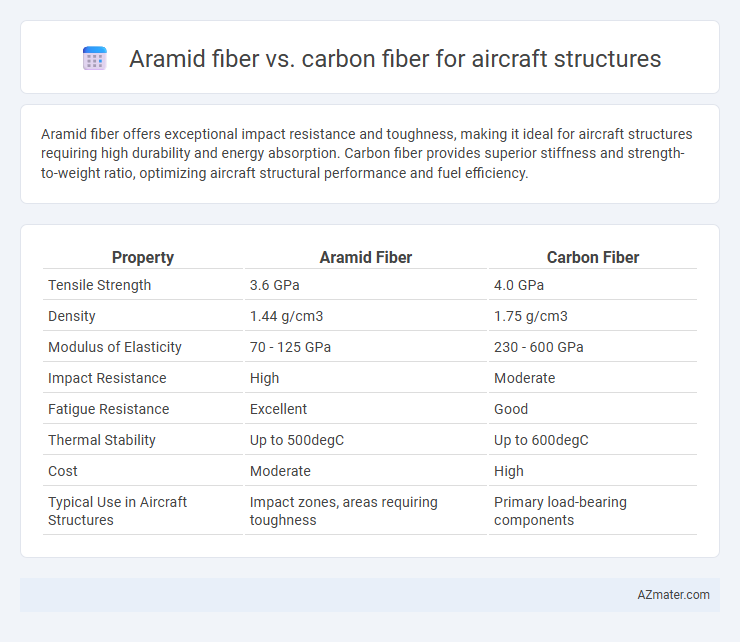Aramid fiber offers exceptional impact resistance and toughness, making it ideal for aircraft structures requiring high durability and energy absorption. Carbon fiber provides superior stiffness and strength-to-weight ratio, optimizing aircraft structural performance and fuel efficiency.
Table of Comparison
| Property | Aramid Fiber | Carbon Fiber |
|---|---|---|
| Tensile Strength | 3.6 GPa | 4.0 GPa |
| Density | 1.44 g/cm3 | 1.75 g/cm3 |
| Modulus of Elasticity | 70 - 125 GPa | 230 - 600 GPa |
| Impact Resistance | High | Moderate |
| Fatigue Resistance | Excellent | Good |
| Thermal Stability | Up to 500degC | Up to 600degC |
| Cost | Moderate | High |
| Typical Use in Aircraft Structures | Impact zones, areas requiring toughness | Primary load-bearing components |
Introduction to Advanced Fibers in Aircraft Structures
Aramid fibers, such as Kevlar, exhibit exceptional impact resistance and high tensile strength, making them ideal for aircraft components requiring superior toughness and damage tolerance. Carbon fibers offer exceptional stiffness, high strength-to-weight ratio, and excellent fatigue resistance, driving their widespread use in primary load-bearing aircraft structures. Both advanced fibers significantly enhance aircraft performance by reducing weight and improving structural integrity, with carbon fiber dominating in rigidity and aramid fiber providing superior energy absorption.
Overview of Aramid Fiber: Properties and Applications
Aramid fibers, such as Kevlar, are renowned for their exceptional tensile strength, impact resistance, and lightweight properties, making them ideal for enhancing aircraft structural components. Their superior energy absorption and damage tolerance improve safety and durability in critical areas like fuselage panels and interior reinforcements. In aerospace applications, aramid fibers are often combined with resin matrices to create composite materials that exhibit high fatigue resistance and thermal stability, crucial for advanced aircraft performance.
Understanding Carbon Fiber: Composition and Strengths
Carbon fiber, composed primarily of carbon atoms bonded in a crystalline structure, offers exceptional tensile strength and stiffness, making it ideal for aircraft structural components. Its high strength-to-weight ratio enhances fuel efficiency and performance by reducing overall aircraft weight while maintaining durability and resistance to fatigue and corrosion. Unlike aramid fibers, carbon fiber provides superior rigidity and thermal stability, crucial for maintaining structural integrity under extreme aerodynamic forces.
Weight Comparison: Aramid vs Carbon Fiber
Aramid fiber exhibits a lower density of approximately 1.44 g/cm3 compared to carbon fiber's density range of 1.6 to 1.8 g/cm3, making aramid fiber lighter by weight per volume. This weight advantage contributes to enhanced fuel efficiency and payload capacity in aircraft structures when aramid fibers are used. However, carbon fiber offers higher stiffness and strength-to-weight ratio, often balancing the choice depending on specific structural requirements.
Mechanical Performance: Tensile Strength and Stiffness
Aramid fiber exhibits high tensile strength ranging from 2,500 to 3,500 MPa, offering excellent impact resistance but lower stiffness around 70-130 GPa, which affects load-bearing capacity in aircraft structures. Carbon fiber provides superior tensile strength up to 7,000 MPa and significantly higher stiffness between 230 and 600 GPa, making it ideal for components requiring exceptional rigidity and lightweight performance. In aircraft structural applications, carbon fiber's high modulus and strength-to-weight ratio enhance durability and fuel efficiency compared to aramid fiber, despite aramid's advantage in impact tolerance.
Durability and Environmental Resistance
Aramid fiber demonstrates exceptional durability in aircraft structures, maintaining high impact resistance and toughness under repetitive stress, which enhances long-term structural integrity. Its superior environmental resistance allows Aramid to withstand moisture, UV radiation, and temperature fluctuations better than Carbon fiber, reducing degradation risks in harsh aerospace environments. Carbon fiber offers higher stiffness and strength-to-weight ratios but is more susceptible to brittle failure and environmental factors such as corrosion and UV damage, limiting its durability compared to Aramid in demanding aircraft applications.
Cost and Manufacturing Considerations
Aramid fiber offers lower material costs and excellent impact resistance, making it a cost-effective choice for certain aircraft structures, especially where toughness is critical. Carbon fiber provides superior stiffness-to-weight ratios but involves higher raw material expenses and more complex manufacturing processes, such as precise layering and curing techniques. Manufacturing carbon fiber components demands advanced tooling and longer cycle times, increasing overall production costs compared to the relatively simpler fabrication of aramid composites.
Repairability and Maintenance Factors
Aramid fiber offers superior impact resistance and flexibility compared to carbon fiber, making it easier to repair minor damages in aircraft structures without extensive downtime. Carbon fiber boasts higher stiffness and strength, but its brittle nature often leads to complex crack repairs requiring specialized techniques and equipment. Maintenance of aramid-based composites typically costs less due to simpler inspection and patching processes, whereas carbon fiber repairs demand precision to maintain structural integrity.
Typical Aircraft Structural Uses: Aramid vs Carbon Fiber
Aramid fiber is commonly used in aircraft for impact-resistant components such as fuselage panels, ballistic protection, and interior parts due to its high toughness and excellent energy absorption. Carbon fiber dominates structural applications requiring superior stiffness and strength-to-weight ratios, including wing spars, fuselage frames, and load-bearing elements. The combination of carbon fiber's rigidity and aramid fiber's damage tolerance enhances overall aircraft performance and safety in critical structural zones.
Final Considerations: Selecting the Right Fiber for Aircraft Structures
Aramid fiber offers exceptional impact resistance and toughness, making it ideal for areas requiring energy absorption and durability in aircraft structures. Carbon fiber provides superior stiffness, high strength-to-weight ratio, and excellent fatigue resistance, which enhances overall structural performance and fuel efficiency. Selecting the right fiber depends on balancing mechanical properties, weight reduction goals, and cost-effectiveness tailored to specific aircraft design requirements.

Infographic: Aramid fiber vs Carbon fiber for Aircraft structure
 azmater.com
azmater.com